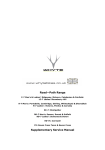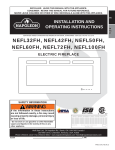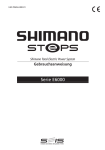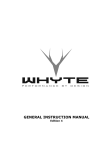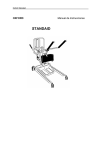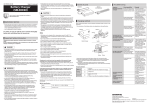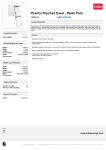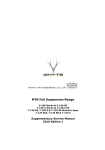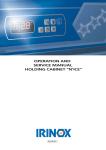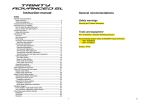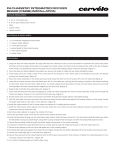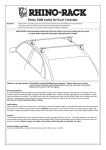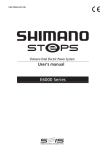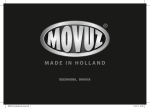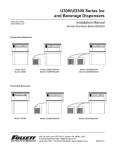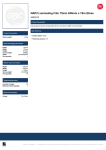Download 2016 Whyte Electric Range Supplementary Service Manual Edn1.pub
Transcript
Electric Range eC-7 Men’s & Women’s: Coniston eR-7: Clifton Supplementary Service Manual 2016 Edition 1 Page 2 2016 Edition 1 Table of Contents 1.0 Introduction 2.0 Geometry: 2.01: Coniston Men’s 2.02: Coniston Ladies 2.03: Clifton 3.0 Preparations for riding: 3.1 Making Adjustments 3.2 Set up of Fork 3.3 Battery maintainance 4.0 Safety 5.0 Lubrication: 5.1 General Lubrication 6.0 Torque Settings 7.0 Notes. 2016 Edition 1 Page 3 WHYTE Service Manual 1.0: INTRODUCTION Thanks for choosing to purchase this Whyte product. We hope you will enjoy all the benefits its advanced design and engineering will bring to your riding experience. This particular range of Electric bikes are fitted with electric pedal assistance, which depends upon how much force you will exert on the pedals. The following specific components are what makes these bikes different from a conventional pedal cycle: • A battery pack fitted above the downtube. • • An electric motor fitted to the bottom-bracket, output power of up to 250 Watts maximum. A controlling system fitted to the handlebars. This manual will guide you through the set-up, safety and maintenance procedures that are specific to your Whyte bike. For other more general information, we strongly advise that you also read thoroughly the General Instruction Manual that is also supplied with your new bike. Also, please note that the specification of all the components that are fitted to your bike as standard may be obtained from the Whyte Bikes Brochure or alternatively from the Whyte Bikes website www.whytebikes.co.uk Please remember, if you are in any doubt about your ability to safely service or repair your Whyte bike, do not ride it and instead arrange for a professional bicycle mechanic at your local Whyte dealer to do the job correctly. Bundled with this manual, are the respective manufacturers instructions and manuals for the branded parts that are fitted to your Whyte bike. Please take time to study all the relevant instruction manuals to ensure you have a continually safe and well set-up bike before every ride, and to help you build up a relationship of knowledge between you and your Whyte Dealer. Happy and safe riding, Whyte design team. May 2015. Page 4 2016 Edition 1 WHYTE Service Manual 2.0: GEOMETRY Fig.1: Geometry 2.01: WHYTE Coniston Men’s Frame Size X Small Medium Large Head Angle A 69.5° 70.0° 70.0° Seat Angle B 74.0° 73.5° 73.0° Top Tube C 591mm 617.6mm 637.8mm BB Height* D 288mm 288mm 288mm Stand Over E 767mm 821mm 825mm Wheel Base F 1107mm 1123mm 1138mm Chain Stay G 445mm 445mm 445mm Seat Post Ø H 30.9mm 30.9mm 30.9mm Note: Geometry shown here is ’Showroom’ i.e. without rider aboard the bicycle. ’With Sag’ geometry is with rider after correct sag is set at the front. Please refer to suspension set up for information on how to achieve the correct sag of the fork. *BB height with Ø706mm tyres fitted (35mm / 37-622) 2016 Edition 1 Page 5 WHYTE Service Manual 2.02: WHYTE Coniston Ladies Frame Size X Small Medium Head Angle A 68.0° 69.0° Seat Angle B 74.5° 74.0° Top Tube C 557mm 584mm BB Height* D 288mm 288mm Stand Over E 716mm 748mm Wheel Base F 1093mm 1106mm Chain Stay G 445mm 445mm Seat Post Ø H 30.9mm 30.9mm Note: Geometry shown here is ’Showroom’ i.e. without rider aboard the bicycle. ’With Sag’ geometry is with rider after correct sag is set at the front. Please refer to suspension set up for information on how to achieve the correct sag of the fork. *BB height with Ø706mm tyres fitted (35mm / 37-622) 2.03: WHYTE Clifton Frame Size X Small Medium Large Head Angle A 70.0° 70.0° 70.0° Seat Angle B 73.5° 73.5° 73° Top Tube C 592mm 606mm 625.4mm BB Height* D 277mm 277mm 277mm Stand Over E 766mm 796mm 823mm Wheel Base F 1100mm 1115mm 1130mm Chain Stay G 450mm 450mm 450mm Seat Post Ø H 30.9mm 30.9mm 30.9mm Note: * BB height with Ø716mm tyres fitted (42-622) Page 6 2016 Edition 1 WHYTE Service Manual 3.0: PREPARATIONS FOR RIDING 3.1: MAKING ADJUSTMENTS Please refer to the specific component manufacturers manual or published technical information about adjusting the components on your Whyte bike. Instructions may be downloaded from the relevant manufacturer’s internet site, as shown in the table to the right. DT www.dtswiss.com Ergon www.ergon-bike.com FSA www.fullspeedahead.com Jagwire www.jagwireusa.com Shimano www.shimano.com SR Suntour www.srsuntour-cycling.com Tektro www.tektro.com www.vittoria.com This electric range of bikes are fitted with the Vittoria Shimano Steps E6000 series of components. VP www.vpcomponents.com Shimano publish comprehensive instructions for these products, which are available from the http://si.shimano.com website, under the E-Bike section on that webpage. User manual UM70H0A-002-00 and Dealer manual DM-SP0001-03 are particularly relevant. If you are uncertain in any way, about making adjustments to any components on you Whyte bike, then DO NOT RIDE YOUR BIKE. Contact your Whyte dealer who will be able to advise you on how to go about setting up you Whyte for riding, and or making adjustments to the components fitted to your Whyte. 3.2: SET UP OF FORK Tools Required: Good Quality Shock Pump. Small Ruler The front fork will be pre-set with the standard settings when you buy your Whyte. Before riding, you will need to adjust the Sag setting on the fork. This is to ensure the forks are setup correctly for your own body weight, so the fork will perform as intended. To set Sag on a front fork, you need to measure the amount the fork compresses when you sit on the bike in the normal riding position. We recommend for the best performance to run approximately (20%) Sag on the front fork. Fork Travel Sag (15% Firm) Sag (25% Plush) 60mm 9mm 15mm Sag on and air sprung fork is controlled by adjusting the Air Spring pressure. We recommend you refer to your forks owners manual or relevant website for detailed information about your fork set up and performance relating to all controls and features of your fork. Rebound Damping adjustment: This adjustment fine-tunes the speed at which the wheel returns to its normal ride height after hitting a bump. To demonstrate the effect of this function, turn the rebound adjuster to its slowest setting. Press down on the handlebars to compress the forks, then release the 2016 Edition 1 Page 7 WHYTE Service Manual load. The suspension recovers very slowly to its original position. Repeat the above with the adjuster turned to the fastest setting and the difference will be seen immediately the load is released. We recommend the optimum setting is to adjust the re-bound damping to be as slow as possible, but not so slow that the normal ride height is not recovered. On very rough terrain, if the bike becomes progressively lower as more bumps are hit then the re-bound damping is set too slow. On the other hand if the bike feels choppy and not plush then the re-bound damping is too fast. A bit of trial and error is needed to get the exact setting. WARNING. Only make adjustments to your fork while stationary, and not when riding. 3.3: BATTERY MAINTAINENCE Tools Required: Shimano charging equipment. Given that the combined mass of the electric power system makes these bikes significantly heavier than equivalent pedal cycles, it is important to avoid running out of battery power whilst riding. Otherwise the bike will be quite a challenge to continue riding! Therefore it is advised to implement the recommendations made by Shimano concerning battery maintenance, charging regime and replacement/disposal, as detailed within the Shimano STEPS User manual UM-70H0A-002-00 and Dealer manual DM-SP0001-03. 4.0: SAFETY IMPORTANT: The following are intended to be advisory notes on the safe use of your Whyte bike. You should also read thoroughly the General Instruction Manual also supplied with your new bike. If at any stage you are uncertain about the safety or safe operation of the bike as a whole, or any specific component, then DO NOT RIDE YOUR WHYTE and instead please consult the specific component manufacturers instruction manual or your Whyte Dealer for advice. Maximum Rider Weight Limit for this range of Whyte Bikes: 19 Stone/120kg WARNING: As is the case with all mechanical components, the bicycle is subjected to wear and high stresses. Different materials and components may react to wear and stress fatigue in different ways. If the design life of a component has been exceeded, it may fail suddenly causing possible injury to the rider. Any form of crack, scratches and decolouring in highly stresses areas are showing that the component has exhausted its life time and has to be replaced. If you are in any doubt about one or more components on your Whyte DO NOT RIDE YOUR BIKE. Consult the specific component manufacturers literature, or take your bike to your local Whyte Dealer. CAUTION: These bikes have disc brakes as standard equipment. It is NOT PERMITTED to convert the braking system to a rim brake type, since the frame has only been tested for disc brake use and also because the wheel rims are not suitable to be used as a braking surface. Making such a modification of components will also void the warranty. Page 8 2016 Edition 1 WHYTE Service Manual WARNING: There are specific safety instructions for the Shimano STEPS electric power system, which are detailed in the Shimano STEPS User manual UM-70H0A002-00 and Dealer manual DM-SP0001-03. In particular, certain potential hazards associated with handling/disposal of the battery and also how to safely utilise the electric motor assistance whilst riding your bicycle. We therefore strongly recommend that these points are studied with great care, to ensure safe operation of your Whyte electric bicycle. Designed for the following use: The bicycles in the Whyte eC-7 & eR-7 series’ have all been designed, tested and comply with ISO 4210-2 Safety Standard, for typical road or path cycling use. They have not been designed or tested for mountain biking or for use in competition. 5.0: LUBRICATION 5.1: GENERAL LUBRICATION For the correct lubrication regime and maintenance of all parts on a Whyte bicycle, please refer to the specific component manufacturers detailed instructions bundled with this manual or for further information visit the specific manufacturers website. 6.0: TORQUE SETTINGS IMPORTANT: For all torque settings, refer to the specific manufacturers information bundled with this manual, or alternatively, refer to the specific manufacturers website for further information. 7.0: NOTES 2016 Edition 1 Page 9 WHYTE Service Manual NOTES (continued) Page 10 2016 Edition 1 WHYTE Service Manual NOTES (continued) 2016 Edition 1 Page 11












